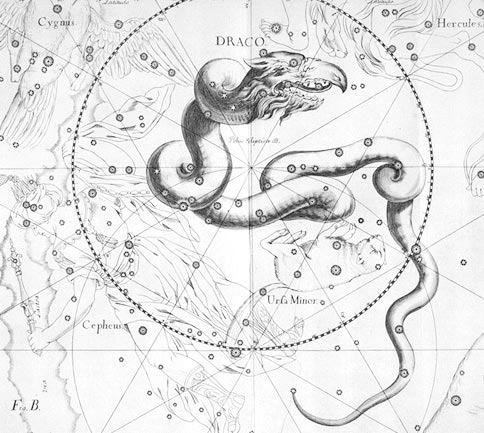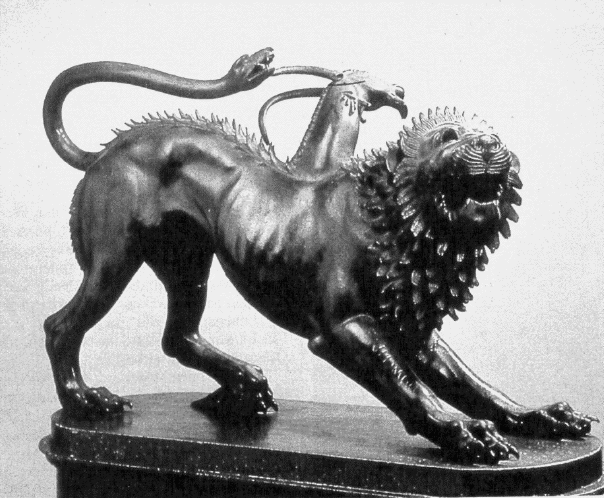Pagan Paths
Hellenismos, otherwise known as Greek Reconstructionist Paganism, is the traditional, polytheistic religion of ancient Greece, reconstructed in and adapted to the modern world. It's a vibrant religion which can draw on a surprising amount of ancient sources. Baring the Aegis blogger Elani Temperance blogs about her experiences within this Tradition.
Constellation Draco: the dragon
The constellation Draco (from the Greek Drakon, meaning dragon) is identified--funnily enough--with some dragons in Hellenic myth but not others. There are quite a few creatures, after all, who would qualify as a dragon in Hellenic myth. For a dragon or hydra not connected to the constellation, think of the one Kadmos vanquished, for example, or the one Apollon vanquished at Delphi, or even the dragon who guarded the Golden Fleece and was slain by Iásōn. In truth, only two dragons were associated with the myth in ancient times, most notably by Hyginus in his Astronomica: Drakon Hesperios, the Hesperian Dragon, and Drakon Gigantomakhios, the Gigantomachian Dragon.
The first of the myths associated with the constellation is the legend of the Drakon Hesperios (Δρακων Ἑσπεριος), who was slain by Hēraklēs during one of his Labours. I will tell the whole myth of the labour soon enough, but I will share what Hyginus wrote about this labour, and Hēraklēs' encounter with Ladôn (Λαδων), as the dragon was often called.
"This huge serpent is pointed out as lying between the two Bears. He is said to have guarded the golden apples of the Hesperides, and after Hercules killed him, to have been put by Juno [Hera] among the stars, because at her instigation Hercules set out for him. He is considered the usual watchman of the Gardens of Juno. Pherecydes says that when Jupiter [Zeus] wed Juno, Terra [Gaea] came, bearing branches with golden applies, and Juno, in admiration, asked Terra to plant them in her gardens near distant Mount Atlas. When Atlas’ daughters kept picking the apples from the trees, Juno is said to have placed this guardian there. Proof of this will be the form of Hercules above the dragon, as Eratosthenes shows, so that anyone may know that for this reason in particular it is called the dragon." [II.3]
The sole other dragon this myth is linked to is Drakon Gigantomakhios (Δρακων Γιγαντομαχιος), who rose up during the Gigantomachy. When the Olympians rose to power, they first fought the Titans during the Titanomachy. Vanquishing them, the Theoi thought They had won. Yet, there was one who sought revenge for the defeat of his father: Typhôeus, the most-feared son of Tartaros and Gaea. Some versions of the myth say that Typhôeus was actually the Drakon Gigantomakhios, or one of his offspring. Hyginus shares what happened to the dragon:
"Some also say this dragon was thrown at Minerva [Athena] by the Giants, when she fought them. Minerva, however, snatched its twisted form and threw it to the stars, and fixed it at the very pole of heaven. And so to this day it appears with twisted body, as if recently transported to the stars."
Because I suddenly realize the association with medieval dragons is very easily made when reading 'dragon', I feel I must explain the word in more depth, because I assure you, the ancient Hellenes were unaccustomed to giant, fire breathing, lizards. The ancient Hellenes knew four types of dragon: the Drakones, the Ketea, the Khimaira and the Drakaenae.
 The Drakones were named after the Greek 'drakein' and 'derkomai, meaning 'to see clearly' or 'gaze sharply'. These were guardians, usually of wells and springs, groves, Gods, or treasure. As guardians, they were usually equipped with sharp fangs, deadly poison and/or multiple heads. In essence, they were however seen as giant snakes which--and this is wholly a personal observation--makes sense when most protective and purifying Theoi were depicted as snakes.
The Drakones were named after the Greek 'drakein' and 'derkomai, meaning 'to see clearly' or 'gaze sharply'. These were guardians, usually of wells and springs, groves, Gods, or treasure. As guardians, they were usually equipped with sharp fangs, deadly poison and/or multiple heads. In essence, they were however seen as giant snakes which--and this is wholly a personal observation--makes sense when most protective and purifying Theoi were depicted as snakes.
Some examples of the Drakones are the Drakon Hesperios (Hesperian Drakon), who guarded the golden apples in the grove of the Hesperides; the Hydra, most famous of all mythological drakons, who had nine, regenerating, heads which grew back in pairs when cut off; and the Drakon Ismenios, who guarded the sacred spring of Ares near Thebes and was slain by Kadmos. The ancient Hellenes also believed that remote, unexplored corners of the earth housed a variety of Drakones, which could be found in Aethiopia, the hills and mountains of India, and in central Anatolia.
The second type were the Ketea, sea-monsters. These resembled snakes, again, but did no guard anything. These were destroyers, usually sent by the Gods in punishment. Cetus, the sea monster sent to ravage the coasts of Aethiopia after a prideful boast by Queen Cassiopeia. Cetus could only be appeased by sacrificing Androméda to it. According to the ancient Hellenes, the Ketea had real-life counterparts as well, in the deep Indian oceans, and in the form of the Scolopendra. Aelian, Hellenic natural historian from the second century AD describes them as follows in his 'On Animals':
"Now in the course of examining and investigating these subjects and what bears upon them, to the utmost limit, with all the zeal that I could command, I have ascertained that the Skolopendra is a Ketos (Sea-Monster), and of Sea-Monsters it is the biggest, and if cast up on the shore no one would have the courage to look at it. And those who are expert in marine matters say that they have seen them floating and that they extend the whole of their head above the sea, exposing hairs of immense length protruding from their nostrils, and the tail is flat and resembles that of a crayfish. And at times the rest of their body is to be seen floating on the surface, and its bulk is comparable to a full-sized trireme. And they swim with numerous feet in line on either side as though they were rowing themselves (though the expression is somewhat harsh) with tholepins hung alongside. So those who have experience in these matters say that the surge corresponds with a gentle murmur, and their statement convinces me." [13.23]
The third type of drakon was the Khimaira, a fire-breathing mythical beast whose form was a hybrid of lion, serpent and goat. Medieval artists used this creature as the template for the Dragon of Saint George, and this form became the link from ancient Hellas to modern D&D creature. The hero Bellerophon was commanded to slay it by King Iobates. He rode into battle against the beast on the back of the winged horse Pegasos and, driving a lead-tipped lance down the Khimaira's flaming throat, suffocated it. From Hómēros' Iliad:
"On first deciphering the fatal message, he ordered Bellerephon to kill the monstrous Chimaera, spawned by gods and not men, that had a lion’s head, goat’s body and serpent’s tail, and breathed out deadly blasts of scorching fire. But Bellerephon slew her, guided by the gods." [VI:119-211]
The Drakaena were hybrids as well, usually with the upper body of a beautiful nymph, and the lower body of a drakon or sea-monster. Most often, these were parents to the above--a necessary evolutionary step. Famous examples include the Goddess Keto, who spawned the Hesperian Drakon, Ekhidna, who was married to the serpent-giant Typhôeus and spawned most of the dragons and monsters of myth, and Skilla, who did not spawn anyone, but was the she-dragon who haunted the Straits of Messina, snapping up sailors from ships--as Odysseus discovered.
These are the four types of drakones the ancient Hellenes identified, some mythological, some actually living in those days. Hopefully this will clear up the confusion of dragons in ancient Hellas and Hellenic myth once and for all.
The constellation Draco is visible at latitudes between +90° and −15°, and best visible at 21:00 (9 p.m.) during the month of July.
Image source: Hydra, Cetus, Khimaira, Skilla.
Comments
-
Please login first in order for you to submit comments
























Release the Kraken...er, Drakon!
Great and informative post. Thanks again.